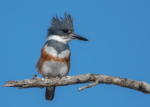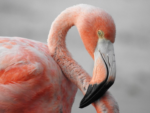Every Friday we invite you and your homeschool students to learn about a different group of North American birds in your recommended bird guide. It’s a great way to add a few minutes of science, geography, natural history, and imagination to your homeschool schedule throughout the year.
This week’s birds (one family) are the Wagtails and Pipits (pages 430–433).
If you’re teaching younger children, the way to use these posts is just to treat your bird guide as a picture book and spend a few minutes each week looking at all the interesting birds they may see one day. With that, your little lesson is done.
If you have older students, one of your objectives should be to help them become fluent with a specialized reference book that’s packed with information, the kind of book they will encounter in many different fields of study. Here’s how your bird guide introduces this week’s birds:
WAGTAILS · PIPITS — Family Motacillidae. Slender-billed birds. Most species pump their tails as they walk. Wagtail flight is strongly undulating. Species: 67 World, 10 N.A. [North America]
When you’re training your young naturalists, teach them to ask and answer from their bird guide some of the first questions any naturalist would ask about a new group. How many species? (67 worldwide.) Are there any near us? (10 species in North America, and the individual maps will give us more detail.) What are their distinctive features? (Slender-billed, pump their tails up and down, undulating flight, and so on.) (And “undulating” is certainly a wonderful word — be sure to send someone to your homeschool dictionary to look that one up!) 🔎
Pick a representative species or two to look at in detail each week and read the entry aloud, or have your students study it and then narrate it back to you, explaining all the information it contains. This week, why not investigate the American Pipit (page 432), the only really widespread American species in the family, found all across the continent.
All sorts of biological information is packed into the brief species descriptions in your bird guide — can your students tease it out? How big is the American Pipit? (6½ inches long.) What is its scientific name? (Anthus rubescens.) Will you be able to find this species where you live? At what times of year and in what habitat? (Study the range map and range description carefully to answer those questions, and see the book’s back flap for a map key.) Do the males and females look alike? The adults and juveniles? What song or call does this species make? How can you distinguish it from similar species? (The text and illustrations should answer all these questions.)
Pipits are rather plain birds of open country, and they are most often seen on the ground or flying in small flocks. They nest in northern tundra regions and commonly winter in open farm fields and waste places, where they are well camouflaged when at rest. Their name comes from their common flight call.
For a second species in the Wagtail and Pipit family this week, take a look at the Eastern Yellow Wagtail (page 430), the only wagtail species that really has gotten a foothold on the North American continent.
Wagtails are found mainly in the Old World, and only a few species have ranges that extend eastward into western Alaska. They are generally more boldly patterned than pipits, but they are also ground-loving birds of open country.
You can do little ten-minute lessons of this kind with any of the species in your bird guide that catch your interest. Pick one that lives near you, or that looks striking, or that has a strange name, and explore.
In all these Friday Bird Families lessons, our aim is not to present a specific set of facts to memorize. We hope instead to provide examples and starting points that you and your students can branch away from in many different directions. We also hope to show how you can help your students develop the kind of careful skills in reading, observation, and interpretation that they will need in all their future academic work.
What ornithological observations and naturalistical notes have you and your students made in your homeschool this Hercules Term? 😊
❡ Homeschool birds: We think bird study is one of the best subjects you can take up in a homeschool environment. It’s suitable for all ages, it can be solitary or social, it can be as elementary or as advanced as you wish, and birds can be found just about anywhere at any season of the year. Why not track your own homeschool bird observations using the free eBird website sponsored by Cornell University. It’s a great way to learn more about what’s in your local area and about how bird populations change from season to season. 🦅
❡ Feed the birds: Setting up a bird feeder is one of the easiest educational activities you can do in a homeschool environment. Here are some tips that will help you get started today! 🐦
❡ Enchiridion: The front matter in your bird guide (pages 6–13) explains a little bit about basic bird biology and about some of the technical terminology used throughout the book — why not have your students study it as a special project. Have them note particularly the diagrams showing the parts of a bird (pages 10–11) so they’ll be able to tell primaries from secondaries and flanks from lores. 🦉
❡ Words for birds: You may not think of your homeschool dictionary as a nature reference, but a comprehensive dictionary will define and explain many of the standard scientific terms you will encounter in biology and natural history, although it will not generally contain the proper names of species or other taxonomic groups that aren’t part of ordinary English. (In other words, you'll find “flamingo” but not Phoenicopterus, the flamingo genus.) One of the most important things students should be taught to look for in the dictionary is the information on word origins: knowing the roots of scientific terms makes it much easier to understand them and remember their meaning. 📖
❡ Come, here's the map: Natural history and geography are deeply interconnected. One of the first questions you should teach your students to ask about any kind of animal or plant is, “What is its range? Where (in the world) does it occur?” Our recommended homeschool reference library includes an excellent world atlas that will help your students appreciate many aspects of biogeography, the science of the geographical distribution of living things. 🌎
❡ Nature notes: This is one of our regular Friday Bird Families posts for homeschool naturalists. Print your own copy of our River Houses Calendar of American Birds and follow along with us! You can also add your name to our free weekly mailing list to get great homeschool teaching ideas delivered right to your mailbox all through the year. 🐦 🦉 🦆 🦃 🦅
❡ Homeschool calendars: We have a whole collection of free, printable, educational homeschool calendars and planners available on our main River Houses calendar page. They will help you create a light and easy structure for your homeschool year. Give them a try today! 🗓
❡ Support our work: If you enjoy our educational materials, please support us by starting your regular Amazon shopping from our very own homeschool teaching supplies page. When you click through from our page, any purchase you make earns us a small commission at no extra cost to you. Thank you for helping us to keep going and growing! 🛒
❡ Join us! The aim of the River Houses project is to create a network of friendly local homeschool support groups — local chapters that we call “Houses.” Our first at-large chapter, Headwaters House, is now forming and is open to homeschoolers everywhere. Find out how to become one of our founding members on the Headwaters House membership page. 🏡




